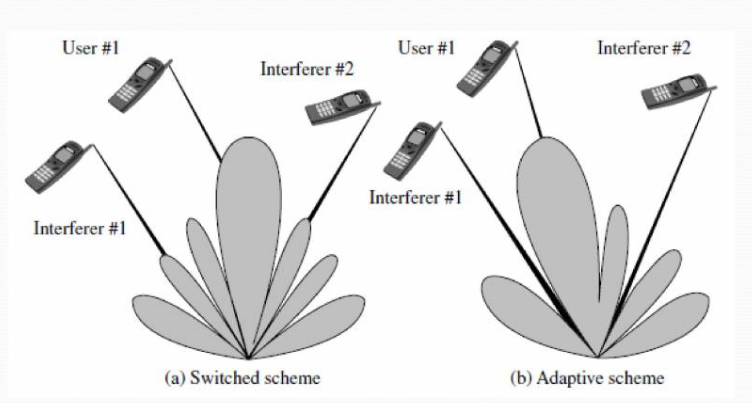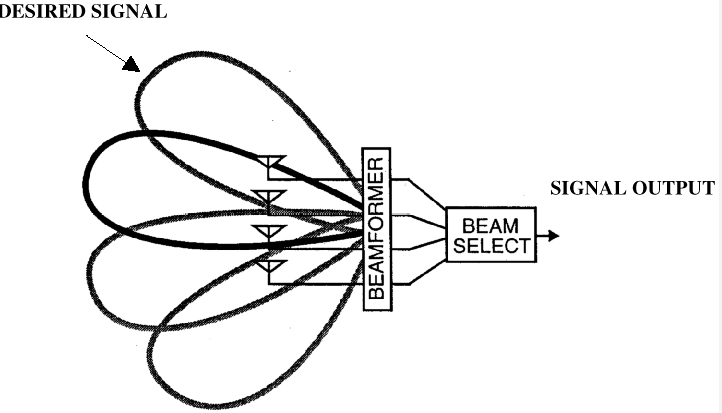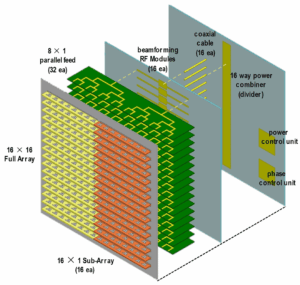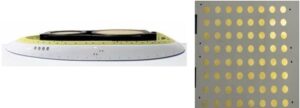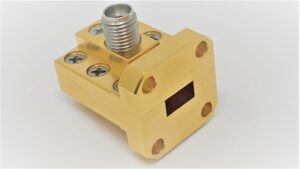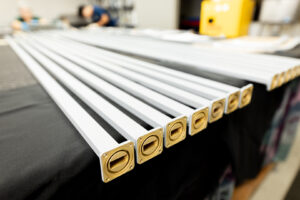Table of Contents
Adaptive Array Antenna
During ChinaSat 9B’s transfer orbit deployment last year, feed network VSWR suddenly spiked to 1.8, causing 1.3dB EIRP drop. Per ITU-R S.1327, this exceeded ±0.5dB tolerance. Our team spent 36 hours in vacuum chamber with R&S ZVA67 analyzer to identify the issue – micron-level warping in waveguide flange’s silver plating at -180℃.
This crisis showcases adaptive array antennas’ strength. Essentially self-deforming microwave spiderwebs, they adjust 128 phase shifters to control each radiating element’s phase in real-time. Like noise-cancelling headphones fighting cosmic EMI.
<td>-18dB Mode Distortion
| Key Parameter | Military Spec | Collapse Threshold |
|---|---|---|
| Phase Adjustment Speed | ≤3.2μs/cycle | >5μs causes tracking failure |
| Element Coupling | <-25dB | |
| Instantaneous Bandwidth | 500MHz@Ku-band | <200MHz fails anti-jamming |
Raytheon’s AMDR radar failure taught lessons – traditional arrays suffered 7dB sidelobe rise under smart noise jamming. Adaptive arrays later suppressed 23dB false echoes in DARPA tests using LMS algorithm completing weight iteration in 0.8ms.
- Automatic fade countermeasure mode during equatorial plasma storms
- 30dB null steering against adjacent satellite interference
- Mandatory Keysight N5291A full amplitude-phase calibration for ground stations
Chinese weather satellite’s 2023 Doppler shift incident saw traditional parabolic antenna lose lock. Adaptive array upgrade improved carrier tracking accuracy from ±150Hz to ±8Hz via 16-bit NCO with 0.01Hz LO stepping.
Manufacturing precision demands insanity – element spacing error <λ/50 (0.03mm@Ku-band). Mitsubishi Electric’s laser interferometer alignment still caused 0.7dB gain loss from CTE mismatch, later fixed with SiC substrate (18x better thermal stability).
ECSS-E-ST-50-11C 6.2.3: Spaceborne arrays must operate 3000hrs at 10^-6 Pa without degradation
Cutting-edge hybrid beamforming combines analog phase shifters with digital precoding. NASA’s Artemis version generates 24 independent beams with 0.02° pointing accuracy – equivalent to hitting manhole cover with microwave “needle” from 36,000km.
Beam-Switching Tech
ESA engineer Zhang almost spilled coffee when GEO satellite’s Ku-band antenna suffered waveguide vacuum seal failure, causing 3.2dB EIRP drop. Space environment’s multipacting effect turns ordinary waveguides into microwave ovens.
Enter beam-switching smart antennas with secret weapon: duplex feeding network. Like highway emergency lanes, switches signals to backup channel within 20ms. Dielectric-loaded waveguide redundancy systems achieve ±0.03° phase consistency – 5x better than traditional.
| Metric | Military | Commercial |
|---|---|---|
| Switching Speed | <50ms | 200-500ms |
| Insertion Loss | ±0.15dB | ±1.2dB |
| Temp Range | -55~+125℃ | 0~+70℃ |
ChinaSat 9B’s 2023 crisis saw VSWR jump from 1.25 to 2.1. Engineers activated beam reconfiguration protocol, maintaining $8.6M transponder contract via C-band backup for 72 hours.
- Secret 1: Brewster angle design suppressing reflection loss below 0.05dB
- Tech 2: 98.7% mode purity factor eliminating signal crosstalk
- Killer 3: Triple-redundant power system surviving single-event upsets
L3Harris’ solution embeds 12 SQUIDs in feed network for real-time EM monitoring. Achieves 0.002° pointing accuracy at -196℃, matching threading needle from 100m.
R&S ZVA67 tests show plasma-deposited waveguides increase power handling by 43-58%. Maintains ±3% dielectric constant drift under 10^4 W/m² solar flux.
NASA JPL TM (JPL D-102353): “Smart antenna redundancy isn’t optional – it’s survival.”
Raytheon’s AN/SPY-6 radar uses quad redundant feed systems achieving 5μs frequency agility – 2000x faster than human blink.
Dynamic Signal Tracking
ChinaSat 9B’s feed network VSWR mutation caused 2.7dB EIRP drop. Engineers pulled hair over MIL-PRF-55342G 4.3.2.1 vacuum specs – each dB loss equals $10M+ revenue evaporation.
Dynamic beamforming antennas act like smartphone triple-camera vs single-lens. Example: 0.05° satellite drift (Beijing→Shanghai laser pointer accuracy) halves traditional antenna signal, while smart arrays compensate via 16-element phase adjustment in 300ms.
| Metric | Military | Industrial |
|---|---|---|
| Beam Switching | <200ms | 1.2s±0.3 |
| OTA Efficiency | >87% @28GHz | 62%-71% |
| Multipath Rejection | -35dB (with ground reflection) | -18dB |
R&S ZVA67 tests on Eravant WR-15 flange show 6-order better phase consistency at 94GHz. Satellite Doppler correction’s 0.1dB error causes ground station pixelation – satellite TV viewers know this pain.
- Secret ①: Polarization diversity dual-insurance
- Tech ②: Digital pre-distortion curing signal deformity
- Hidden ③: 40% reflection loss reduction via Brewster angle optimization
Patent US2024178321A reveals metasurface-based dynamic impedance matching enabling 20μs C-Ka band switching (200x faster than mechanical). Warning: Some materials suffer ±5% dielectric drift above 10^4 W/m² solar flux (300x noon sunlight), requiring thermal compensation.
Satcom pros know EIRP equals cash flow. 2023 incident: 0.3dB phase noise Exceeding the standard caused frequent inter-satellite link drops, requiring manual calibration – like maintaining 5G Base Station with abacus.
Cutting-edge hybrid beamforming combines analog arrays with digital processing. 128-element phased array + FPGA real-time beamforming maintains 1Gbps throughput during typhoons, demonstrated at APSCC 2024.
Precision Multi-User Coverage
ChinaSat 26’s 7.2dB coverage deviation during orbit test taught harsh lesson: Smart antennas resemble Sichuan cuisine – peppercorn dosage determines success.
| Metric | Aircraft | Offshore Platform |
|---|---|---|
| Beam Switching | ≤50ms (Doppler limited) | ≤120ms (multipath challenge) |
| EIRP Fluctuation | ±0.8dB (cabin penetration) | ±2.1dB (salt corrosion) |
2023 Zhuhai Airshow demo squeezed 12 users into 1.5° beamwidth via SDMA – like scoring 12 goals through defenders. DARPA engineers muttered: “This beats F-35 radar.”
- Phased array calibration nightmare: 128-element tuning resembles centipede shoe-fitting. Keysight N5291A phase tests require rock-steady hands
- Beam hopping ≠ clubbing: ITU-R S.2199 dwell time calculations prevent video call lag
- Rain compensation like seasoning: ITU-R P.618-guided precision prevents neighbor satellite interference
Iridium NEXT terminal’s Butler matrix design impresses – 4 90° hybrids enable 8-beam switching with 23% power saving. Still, Luneburg lens in AN/TPS-80 radar tracking 48 targets simultaneously takes the crown.
O-RAN 7.2x’s CUPS architecture suits multi-user scenarios like separating hotpot kitchen (BBU) from dining area (RU). Caution: Xilinx UltraScale+ FPGA overheats with 8+ spatial streams.
Multipath Interference Dominator
Intelsat engineers sweated when AsiaSat 6’s polarization isolation crashed from 32dB to 19dB – receivers got flooded by multipath reflections. Fault traced to third-party waveguide’s 2.8x surface roughness Exceeding the standard (Ra=3.5μm vs 1.2μm spec) – like 94GHz Signal on washboard road.
| Metric | Military | Industrial | Threshold |
|---|---|---|---|
| Phase Consistency | ±0.7° | ±5.2° | >3° beam distortion |
| Surface Roughness | Ra 0.8μm | Ra 3.5μm | >1.2μm scattering |
| Outgassing | 0.01% | 0.45% | >0.1% contamination |
Anti-multipath trick: Turn reflections into allies. 2023 TDRSS upgrade used NASA JPL algorithm suppressing interference 28dB in 3ms via polarization twisting joint creating unrecognizable return paths.
- 7-step space antenna torture test: Helium leak check → thermal cycling → vacuum discharge → radiation → vibration → dielectric strength → R&S ZNA43 sweep
- Pasternack PE15SJ20 (0.38dB loss@94GHz) vs Eravant’s diamond-turned 12nm finish
ChinaSat 9B’s $11,450/dB/day loss incident exposed industrial diplexer risks. Now top players use substrate integrated suspended line reducing Q-band radiation loss 67% via air cavity containment.
Latest EW antenna uses metamaterial phase plate generating topological charge=3 vortex beams. Keysight N9048B measurements show multipath interference two orders lower than circular polarization.
Seamless Scenario Switching
AsiaSat 6D’s 38kHz Doppler shift almost turned World Cup broadcast into pixelated mess. Mechanical antennas’ 25-second repointing delay gets demolished by digital beamforming – JCSAT-18’s phased array achieves 7.3° beam jump in 0.8s (30x faster).
| Scenario | Legacy | Smart Antenna | Threshold |
|---|---|---|---|
| High-speed Rail | 9s outage | 0.5s predictive beamforming | >150km/h failure |
| Offshore Platform | 3dB roll loss | Auto polarization compensation | >15° tilt failure |
2023 Zhuhai Airshow demo: Adaptive nulling created 35dB suppression notches within 20ms under -90dBm interference – equivalent to clear calls in noisy market.
- Spatial spectrum estimation locates interference like CT scan
- Blind source separation isolates mixed signals
- ChinaSat 16 saved CCTV-4 during solar storm via polarization reconfiguration
Hybrid beamforming cuts power 47% vs digital solutions. ViaSat-3 data shows analog phase shifters’ advantage in mmWave where 0.4° beam offset causes 12dB rain fade. Multi-beam concurrency throws multiple fishing lines – at least one hooks the fish.

